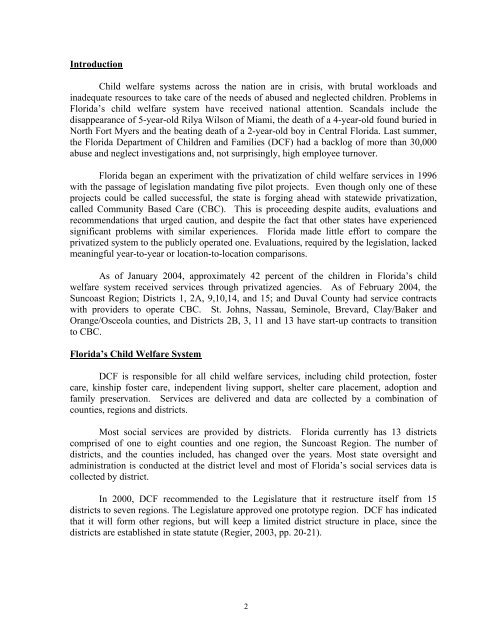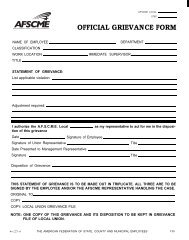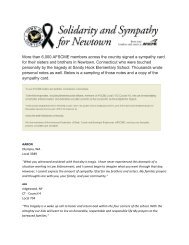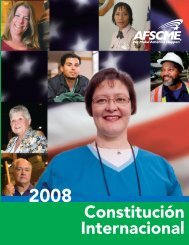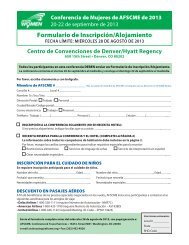Florida's Experiment with Privatizing Child Welfare Services - AFSCME
Florida's Experiment with Privatizing Child Welfare Services - AFSCME
Florida's Experiment with Privatizing Child Welfare Services - AFSCME
- No tags were found...
You also want an ePaper? Increase the reach of your titles
YUMPU automatically turns print PDFs into web optimized ePapers that Google loves.
Introduction<strong>Child</strong> welfare systems across the nation are in crisis, <strong>with</strong> brutal workloads andinadequate resources to take care of the needs of abused and neglected children. Problems inFlorida’s child welfare system have received national attention. Scandals include thedisappearance of 5-year-old Rilya Wilson of Miami, the death of a 4-year-old found buried inNorth Fort Myers and the beating death of a 2-year-old boy in Central Florida. Last summer,the Florida Department of <strong>Child</strong>ren and Families (DCF) had a backlog of more than 30,000abuse and neglect investigations and, not surprisingly, high employee turnover.Florida began an experiment <strong>with</strong> the privatization of child welfare services in 1996<strong>with</strong> the passage of legislation mandating five pilot projects. Even though only one of theseprojects could be called successful, the state is forging ahead <strong>with</strong> statewide privatization,called Community Based Care (CBC). This is proceeding despite audits, evaluations andrecommendations that urged caution, and despite the fact that other states have experiencedsignificant problems <strong>with</strong> similar experiences. Florida made little effort to compare theprivatized system to the publicly operated one. Evaluations, required by the legislation, lackedmeaningful year-to-year or location-to-location comparisons.As of January 2004, approximately 42 percent of the children in Florida’s childwelfare system received services through privatized agencies. As of February 2004, theSuncoast Region; Districts 1, 2A, 9,10,14, and 15; and Duval County had service contracts<strong>with</strong> providers to operate CBC. St. Johns, Nassau, Seminole, Brevard, Clay/Baker andOrange/Osceola counties, and Districts 2B, 3, 11 and 13 have start-up contracts to transitionto CBC.Florida’s <strong>Child</strong> <strong>Welfare</strong> SystemDCF is responsible for all child welfare services, including child protection, fostercare, kinship foster care, independent living support, shelter care placement, adoption andfamily preservation. <strong>Services</strong> are delivered and data are collected by a combination ofcounties, regions and districts.Most social services are provided by districts. Florida currently has 13 districtscomprised of one to eight counties and one region, the Suncoast Region. The number ofdistricts, and the counties included, has changed over the years. Most state oversight andadministration is conducted at the district level and most of Florida’s social services data iscollected by district.In 2000, DCF recommended to the Legislature that it restructure itself from 15districts to seven regions. The Legislature approved one prototype region. DCF has indicatedthat it will form other regions, but will keep a limited district structure in place, since thedistricts are established in state statute (Regier, 2003, pp. 20-21).2


